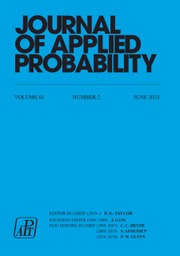Crossref Citations
This article has been cited by the following publications. This list is generated based on data provided by
Crossref.
Federgruen, A.
and
Zheng, Y.-S.
1993.
Optimal Control Policies for Stochastic Inventory Systems with Endogenous Supply.
Probability in the Engineering and Informational Sciences,
Vol. 7,
Issue. 2,
p.
257.
1994.
Markov Decision Processes.
p.
613.
Gerchak, Yigal
and
Wang, Yunzeng
1994.
Periodic-review inventory models with inventory-level-dependent demand.
Naval Research Logistics,
Vol. 41,
Issue. 1,
p.
99.
Özekici, Süleyman
1996.
Reliability and Maintenance of Complex Systems.
p.
137.
Beyer, D.
and
Sethi, S. P.
1997.
Average Cost Optimality in Inventory Models with Markovian Demands.
Journal of Optimization Theory and Applications,
Vol. 92,
Issue. 3,
p.
497.
Beyer, Dirk
and
Sethi, Suresh
1997.
Average Cost Optimality in Inventory Models with Markovian Demands: A Summary.
SSRN Electronic Journal,
Kapuściński, Roman
and
Tayur, Sridhar
1998.
A Capacitated Production-Inventory Model with Periodic Demand.
Operations Research,
Vol. 46,
Issue. 6,
p.
899.
Beyer, D.
and
Sethi, S. P.
1999.
The Classical Average-Cost Inventory Models of Iglehart and Veinott–Wagner Revisited.
Journal of Optimization Theory and Applications,
Vol. 101,
Issue. 3,
p.
523.
Assimakopoulos, Nikitas A.
1999.
Random environmental processes for complex computer systems: a theoretical approach.
Advances in Complex Systems,
Vol. 02,
Issue. 02,
p.
117.
Bollapragada, Srinivas
and
Morton, Thomas E.
1999.
A Simple Heuristic for Computing Nonstationary (s, S) Policies.
Operations Research,
Vol. 47,
Issue. 4,
p.
576.
Axsäter, Sven
2000.
Inventory Control.
Vol. 26,
Issue. ,
p.
25.
Gallego, Guillermo
and
Scheller-Wolf, Alan
2000.
Capacitated inventory problems with fixed order costs: Some optimal policy structure.
European Journal of Operational Research,
Vol. 126,
Issue. 3,
p.
603.
Flynn, James
2000.
SelectingT for a periodic review inventory model with staggered deliveries.
Naval Research Logistics,
Vol. 47,
Issue. 4,
p.
329.
ARSLAN, HASAN
AYHAN, HAYRIYE
and
OLSEN, TAVA LENNON
2001.
Analytic models for when and how to expedite in make-to-order systems.
IIE Transactions,
Vol. 33,
Issue. 11,
p.
1019.
Gallego, Guillermo
and
Özer, Özalp
2001.
Integrating Replenishment Decisions with Advance Demand Information.
Management Science,
Vol. 47,
Issue. 10,
p.
1344.
Chen, Frank Y.
and
Krass, Dmitry
2001.
Inventory models with minimal service level constraints.
European Journal of Operational Research,
Vol. 134,
Issue. 1,
p.
120.
Beyer, Dirk
Sethi, Suresh P.
and
Sridhar, Ramaswamy
2002.
Decision & Control in Management Science.
Vol. 4,
Issue. ,
p.
241.
Fleischmann, Moritz
Kuik, Roelof
and
Dekker, Rommert
2002.
Controlling inventories with stochastic item returns: A basic model.
European Journal of Operational Research,
Vol. 138,
Issue. 1,
p.
63.
Rosling, Kaj
2002.
Inventory Cost Rate Functions with Nonlinear Shortage Costs.
Operations Research,
Vol. 50,
Issue. 6,
p.
1007.
Fleischmann, Moritz
and
Kuik, Roelof
2003.
On optimal inventory control with independent stochastic item returns.
European Journal of Operational Research,
Vol. 151,
Issue. 1,
p.
25.

